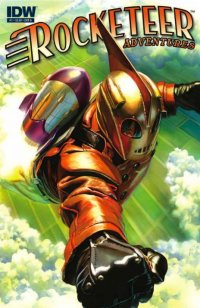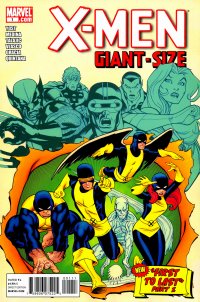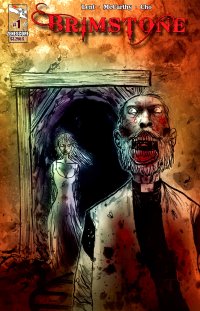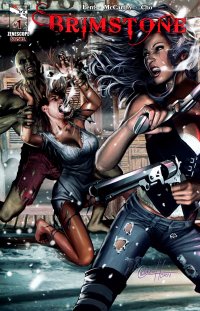Rocketeer Adventures #1 (IDW Publishing, $3.99)
By Devon Sanders
I’ll never forget the first time I laid eyes on The Rocketeer, it was a revelation. It was as if I’d found sugar for the eyes. Rocketeer writer/artist/creator Dave Stevens’ art was filled with lush, energetic Art Deco imagery. Heck, I earned an appreciation of Art Deco from those pages. And Stevens’ figure work… Oh, my God, his figure work. I pretty much discovered what my image of an ideal woman was from those pages. I, like many, discovered Bettie Page within the pages of The Rocketeer. Long story short, I fell deep in love within those pages. Stevens could never be considered prolific but within the 120-plus pages of Rocketeer story produced, a work that will certainly be studied and more importantly, treasured, was given to the medium of comics. With his 2008 passing, the hopes of new Rocketeer material faded. Many thought The Rocketeer was too singular a creation for others to take on. Luckily for us, IDW Publishing with Rocketeer Adventures #1 and some of comics’ greatest working writers and artists have taken up the flag and raised it up high.
Artist and now, writer John Cassaday crafts an adrenaline fueled, muscular story pitting The Rocketeer against a rocket, unfortunately, carrying the love of his life. It’s a simple story and predictable story but I’ll be damned if it didn’t find it charmingly suspenseful with a perfectly fitting ending. Cassaday’s art is beautiful and I had to, at times, I had to remind myself that I wasn’t looking at “lost” Stevens artwork.
Writer/artist Mike Allred comes through with a story that, at its core, is nothing but an excuse for him to draw The Rocketeer flying through his beautifully rendered New York architecture. Allred, being the master artist he is, needs no other reason. The only misfire in this story is the lettering. It’s simply too jagged, harsh and distracting, lacking the flair contained within his art.
Finally, writer Kurt Busiek and artist Michael K. Kaluta contribute a Bettie story set in the waning days of WWII. It’s quite a nice little story focusing on hope and commitment with an ending that cements The Rocketeer Adventures as something well worth revisiting.
With an Alex Ross cover and “pin-up” contributions by Jim Silke and Hellboy creator Mike Mignola, Rocketeer Adventures #1 proves The Rocketeer legacy, is still as viable and vibrant to our comics medium as ever.
Rating: 




Out of a Possible 5 Stars
 X-Men Giant-Size #1 (Marvel, $4.99)
X-Men Giant-Size #1 (Marvel, $4.99)
By Jeb D.
The name “Giant-Size X-Men #1” may not have the same cachet as, say, “Action Comics #1,” but it does have its own special resonance: Len Wein and Dave Cockrum used that book to establish many of the characters and tropes that would dominate superhero storytelling for the next few decades, so choosing to recycle the book’s title ought to signal something of unusual significance for Marvel’s merry mutants. I suppose that “significance” is something that will be decided by posterity, but this is one of the least “unusual” X-Men comics I’ve ever read.
I don’t even know how (or why) to describe the story: the comic is mostly a pair of classic “X-Men versus monsters/supervillains-oh-wait-maybe-they’re-not”, mega-fight scenes, one contemporary, one a flashback that dovetails with the present-day storyline (if I can call it that). The current threat, it would seem, is linked to the previous one, but–and you’ll never see this one coming–no one remembers, because Jean Grey (remember her?) MADE THEM ALL FORGET! That the threat introduced here will percolate through the rest of the X books is a little depressing, given that it feels pretty mundane, but three decades on from the original Giant-Size #1, I suppose there’s only so much new left under the mutant sun.
Writer Chris Yost knows the team well, of course, so we do get the odd character moment here and there, but honestly, most of the time they’re not fighting, they’re just spouting balloon after balloon of exposition, trying desperately to raise the stakes to something approaching the Claremont/Byrne epics (we have not one, but two, “even-superior-to-homo-superior” races in this comic), and not getting even close.
The artwork is serviceable enough: Paco Medina and Juan Vlasco make the modern section look competent and polished (maybe too much so, as Emma’s curves have been reduced to angles), and Dalabor Talajic does the old-school stuff reasonably well (though in the quieter moments, his anatomy and facial expressions can get a little wonky). But honestly, there’s much better X books out there right now, and I can’t imagine plunking down three bucks on this, much less five.
Rating: 




Out of a Possible 5 Stars
Brimstone #1 (Zenescope, $3.25)

By Jeb D.
The “weird Western” seems to be a thriving subgenre these days (what ever happened to Kevin Ferrara, anyway? Deadlander/Dead Rider was one gorgeous comic), and Brimstone is a promising addition.
Set in Nevada at the time of the Civil War, Brimstone #1 emulates filmic quick-cutting to build its story (this is definitely structured as an “introductory” issue), as a series of meetings and dialog exchanges lay out the book’s cross between spaghetti Western and an old issue of CREEPY or EERIE. When insensitive mining types exploit the native peoples and their land, they’re hit with a supernatural curse, and the corrupt white men running the place assemble a pack of badasses to find out what’s happening and put an end to the spooks and monsters.
The painted art by Hyunsang Michael Cho is quite terrific: like a lot of artists working in the horror vein these days, he’s comparable to Clayton Crain, but he gets a rougher texture that evokes the grit and dust of a classic Western (though unlike in, say, a Leone film, there’s not a whole lot of sunlight).
I like the exuberance of the storytelling from Michael Lent & Brian McCarthy, and they’ve done an excellent job of revealing just enough of their story to get us hooked (like the way that the introduction of a female character who is evidently going to be a significant player in the story is handled in a subtle last-panel glimpse). If the plot is derivative, they’ve made its borrowed bits feel fresh so far; there’s always the chance they won’t stick the landing (PLEASE tell me there’s something more interesting than Wild West zombies on the way), but I’m onboard for now.
 I’m not entirely sold on the scripting (as opposed to the story): when you make your band of badasses a set of Western stereotypes (the assembled team, as one character puts it, constitutes “a paddy, a mute, a chink, and a slave”), it seems disingenuous, at best, to try to score points about tolerance and diversity (the character of the slave is named “Black Jackson,,” and the Irish character is practically portrayed as a leprechaun, for heaven’s sake). Lent & McCarthy manage to avoid too much of that sort of 21st-century-PC intrusion into 19th-century thinking, though, mostly getting down to business, and if the dialogue tends mostly to the functional, they do get off the occasional zinger (Victor, the Clint Eastwood standin, is asked “You gotta last name?“; to which he replies “It slowed me down.“).
I’m not entirely sold on the scripting (as opposed to the story): when you make your band of badasses a set of Western stereotypes (the assembled team, as one character puts it, constitutes “a paddy, a mute, a chink, and a slave”), it seems disingenuous, at best, to try to score points about tolerance and diversity (the character of the slave is named “Black Jackson,,” and the Irish character is practically portrayed as a leprechaun, for heaven’s sake). Lent & McCarthy manage to avoid too much of that sort of 21st-century-PC intrusion into 19th-century thinking, though, mostly getting down to business, and if the dialogue tends mostly to the functional, they do get off the occasional zinger (Victor, the Clint Eastwood standin, is asked “You gotta last name?“; to which he replies “It slowed me down.“).
I’ve included both covers in this review (one by Ben Templesmith, one by Greg Horn) because if their diametric opposition to each other actually represents the schizoid nature of what’s to come, this book could wind up being a bit of a mess. But let’s think positive.
Rating: 




Out of a Possible 5 Stars